World's Most Fascinating Cemeteries
Every major city in the world has some sort of ostentatious cemetery. Humans have privileged their deceased since the dawn of time. From simple and elegant megalithic tomb to the magnificence of pyramids, humans have providing the dead a respectable farewell. We stagger upon these "cities of the dead", usually that are centuries-old path cut of walled foliage and marble on the fringes of the city, broad leafy trees wilt over mismatched wobbly gravestone and heroic statuette of angel gesture us in. New graveyards include the widest possible range from park-like settings with uncomplicated tombstones to intricate cities of the dead with structural design challenging buildings designed for the living. Basic or grandiloquent, these memorial parks tell us not only how people died, but also how they lived.
Kalavryta - Peloponnese Peninsula, Greece: The only graveyard in the world where so many of the graves carry the same death date: December 13, 1943. The most tear jerking cemetery of the world is the Kalavryta. Most of the graves carry the date when the Nazis came to town in a vicious act of retaliation killing several German soldiers. In reprisal, German groups ordered all the male populace of Kalavryta, men and boys aged 12 years and up, to congregate in a field outside the town. Once gathered, veiled machine guns scythed them down. The Nazis burned down the village later.
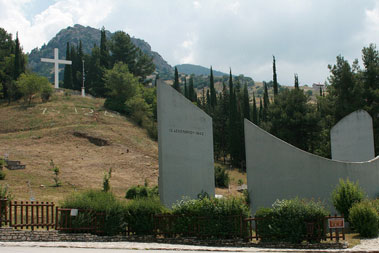
Today, the town of Kalavryta is a beautiful town famous for being the last stop of the picturesque Odontotos Railway. Nevertheless, melancholy still suffuses the town. The house of worship was remodeled after the bloodbath, but the clock remains jarringly fixed at 2:34 - the time, as a plaque elucidates, "When the lament began."
Pere Lachaise, Paris:
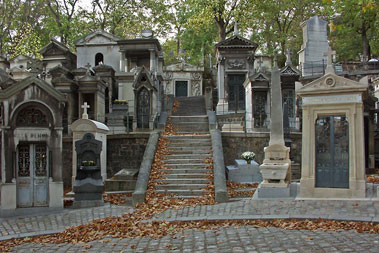
One of the world's most famous cemeteries with over seventy thousand burial places, Pere Lachaise was set up in 1804 and is the biggest burial ground of Paris. An eloquently striking place, the Pere Lachaise is an accurate city of the lifeless, fringed with trees and unmistakably posted street names. The graveyard is the last homes to the most famous and rich including Oscar Wilde, Abelard and Heloise who were the ill-starred lovers and tuneful gifted like Chopin, Edith Piaf, and Jim Morrison. But it also houses the strangely popular grave of Victor Noir. The place also has expressive statuette at every turn and lanes of flamboyant designs, alongside tombs.
La Recoleta, Buenos Aires:
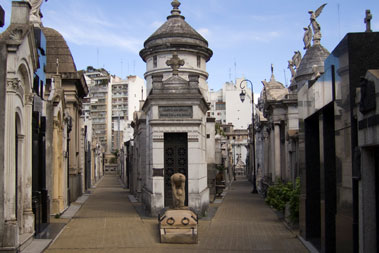
Another graceful magnum opus of architecture for eternal life, La Recoleta is situated in an elegant Buenos Aires environs. The wide pathways that are guarded by the resident cats are lined with crypts that are worth mentioning for their variety of styles - cathedral, art nouveau and avant-garde boxes. Also known for its assorted cipher including a menorah with a cross, Masonic pyramids, and even some statues of pagan gods, the burial ground's most famous resident is Eva Peron though the most tragic story is that of Rufina Cambaceres.
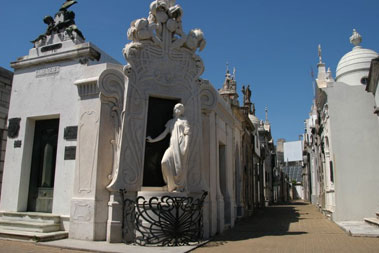
La Chiesa dei Morti, Italy:
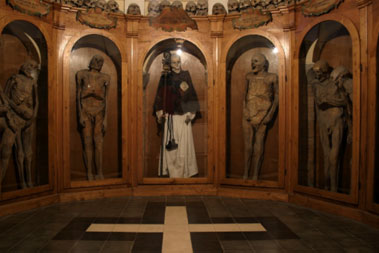
A tiny church and the chief attraction of Urbania, La Chiesa dei Morti or the "Church of the Dead" ,are also known as the mummy cemetery. When visitors enter the Baroque doorway, they are brought into the chapel where a ghoulish exhibit is kept. Eighteen mummies stand in individual glass-cases since 1833 behind the altar. These have been naturally mummified due the existence of a mold that absorbed moisture from the corpses leading to complete desiccation of the bodies. Each of the mummies has a story to tell which the tour guide will explain about their passing away. But the ones which are very often said are about the one, which suffered from Down's syndrome, died of heart failure; another died while in labor; one was murdered.
The Neptune Memorial Reef:
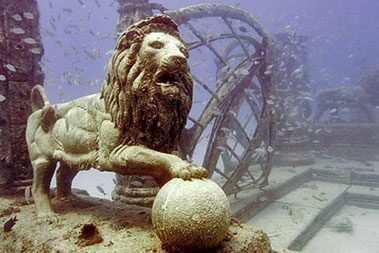
Also known as the Atlantis Memorial Reef, the Neptune Memorial Reef is the ultimate final resting place for the sea-lovers. This underwater burial ground is now the world's largest man-made reef that covers about sixteen acres of the sea-bed. Situated off the coast of Key Biscayne in Florida, it is anticipated to house over 850 remains. Cremated vestiges are assorted into different structures and columns
Okuno-in Cemetery - Mt. Koya, Japan:
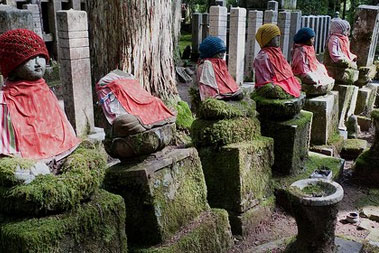
Located in Mount Koya, a sacred village with over 120 Buddhist temples, the best time to visit the Okuno-in is at twilight when stone lanterns contour the snaky paths that lead the way across a stone forest of columns and statuettes that are sculpted in the archetypal Buddha seated position. The graveyard's most legendary dweller is Kobo Daishi, the founder of Shingon Buddhism and the graveyard also has numerous figurine of Jizo- the most adored of the Japanese divinity.
Kalavryta - Peloponnese Peninsula, Greece: The only graveyard in the world where so many of the graves carry the same death date: December 13, 1943. The most tear jerking cemetery of the world is the Kalavryta. Most of the graves carry the date when the Nazis came to town in a vicious act of retaliation killing several German soldiers. In reprisal, German groups ordered all the male populace of Kalavryta, men and boys aged 12 years and up, to congregate in a field outside the town. Once gathered, veiled machine guns scythed them down. The Nazis burned down the village later.

Today, the town of Kalavryta is a beautiful town famous for being the last stop of the picturesque Odontotos Railway. Nevertheless, melancholy still suffuses the town. The house of worship was remodeled after the bloodbath, but the clock remains jarringly fixed at 2:34 - the time, as a plaque elucidates, "When the lament began."
Pere Lachaise, Paris:

One of the world's most famous cemeteries with over seventy thousand burial places, Pere Lachaise was set up in 1804 and is the biggest burial ground of Paris. An eloquently striking place, the Pere Lachaise is an accurate city of the lifeless, fringed with trees and unmistakably posted street names. The graveyard is the last homes to the most famous and rich including Oscar Wilde, Abelard and Heloise who were the ill-starred lovers and tuneful gifted like Chopin, Edith Piaf, and Jim Morrison. But it also houses the strangely popular grave of Victor Noir. The place also has expressive statuette at every turn and lanes of flamboyant designs, alongside tombs.
La Recoleta, Buenos Aires:

Another graceful magnum opus of architecture for eternal life, La Recoleta is situated in an elegant Buenos Aires environs. The wide pathways that are guarded by the resident cats are lined with crypts that are worth mentioning for their variety of styles - cathedral, art nouveau and avant-garde boxes. Also known for its assorted cipher including a menorah with a cross, Masonic pyramids, and even some statues of pagan gods, the burial ground's most famous resident is Eva Peron though the most tragic story is that of Rufina Cambaceres.

La Chiesa dei Morti, Italy:

A tiny church and the chief attraction of Urbania, La Chiesa dei Morti or the "Church of the Dead" ,are also known as the mummy cemetery. When visitors enter the Baroque doorway, they are brought into the chapel where a ghoulish exhibit is kept. Eighteen mummies stand in individual glass-cases since 1833 behind the altar. These have been naturally mummified due the existence of a mold that absorbed moisture from the corpses leading to complete desiccation of the bodies. Each of the mummies has a story to tell which the tour guide will explain about their passing away. But the ones which are very often said are about the one, which suffered from Down's syndrome, died of heart failure; another died while in labor; one was murdered.
The Neptune Memorial Reef:

Also known as the Atlantis Memorial Reef, the Neptune Memorial Reef is the ultimate final resting place for the sea-lovers. This underwater burial ground is now the world's largest man-made reef that covers about sixteen acres of the sea-bed. Situated off the coast of Key Biscayne in Florida, it is anticipated to house over 850 remains. Cremated vestiges are assorted into different structures and columns
Okuno-in Cemetery - Mt. Koya, Japan:

Located in Mount Koya, a sacred village with over 120 Buddhist temples, the best time to visit the Okuno-in is at twilight when stone lanterns contour the snaky paths that lead the way across a stone forest of columns and statuettes that are sculpted in the archetypal Buddha seated position. The graveyard's most legendary dweller is Kobo Daishi, the founder of Shingon Buddhism and the graveyard also has numerous figurine of Jizo- the most adored of the Japanese divinity.